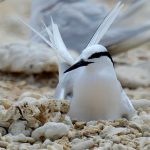BLACK-NAPED TERN
The Black-naped Tern is quite petite, measuring approximately 30 to 36 cm. from the tip of the beak to the end of its tail. It is lightweight at around 100 to 120 grams. This size allows the Black-naped Tern to be incredibly agile and graceful in the air, capable of swift turns and dives as it hunts for fish, skimming the ocean’s surface. Their slender bodies and relatively long wings that ranges from 58 to 65 cm. are perfectly designed for a life spent soaring over the open sea, a testament to the incredible adaptability and specialization of seabirds.
The Black-naped Tern has a lifespan that can stretch up to around 17 years in the wild, a testament to its resilience and adaptability in the vast and sometimes harsh marine environment. These birds are not just visual marvels; they are also vocal artists of the skies. Their calls, a sharp and clear “kip” or “kit”, serve as a symphony of the seas, echoing across the waves. These vocalisations play a crucial role in their social interactions, from courtship to the coordination within their colonies.
The Black-naped Tern is a traveller of the tropical and subtropical oceans, with a presence that spans across the Indian Ocean to the western and central Pacific Ocean. These birds are often found nesting and breeding on remote, uninhabited islands, choosing locations that are safe from predators and human disturbance. Australia’s northern islands, along with parts of Southeast Asia, are among the places where these elegant terns can be found, painting the sky with their graceful flights.
When it comes to breeding, the Black-naped Tern exhibits remarkable dedication. They typically form monogamous pairs, with both parents sharing the responsibilities of nest-building, incubating the eggs, and feeding the chicks. Their nests are often simple scrapes in the sand or on coral rubble, situated on low-lying islands or cays. These strategic locations help protect their eggs and chicks from potential threats, ensuring the continuation of their lineage.
The breeding season varies depending on their location, but generally, it occurs during the warmer months, when food is plentiful. This timing ensures that the parents can provide for their chicks, feeding them a diet rich in fish and small marine invertebrates. Watching a pair of Black-naped Terns work in tandem to raise their young is a heartwarming sight, a testament to the enduring bonds and instincts that drive the natural world.
As we marvel at the beauty and resilience of the Black-naped Tern, let us also remember our shared responsibility to protect these wonders of nature. By fostering a deeper understanding and appreciation of wildlife, we can inspire actions that contribute to the conservation of our planet’s incredible biodiversity. Together, we can ensure that the Black-naped Tern continues to grace our skies and seas for generations to come.
















